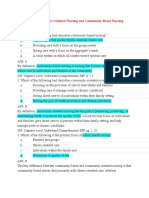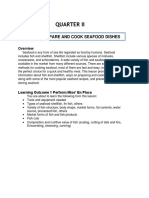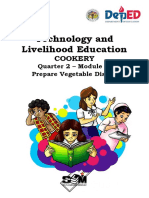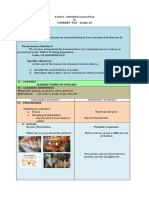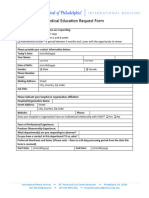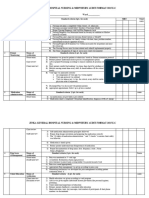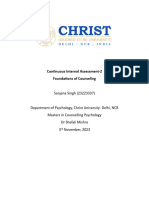Professional Documents
Culture Documents
COOKERY 10 Quarter 2 LAS No. 3
COOKERY 10 Quarter 2 LAS No. 3
Uploaded by
Chema PacionesOriginal Description:
Copyright
Available Formats
Share this document
Did you find this document useful?
Is this content inappropriate?
Report this DocumentCopyright:
Available Formats
COOKERY 10 Quarter 2 LAS No. 3
COOKERY 10 Quarter 2 LAS No. 3
Uploaded by
Chema PacionesCopyright:
Available Formats
Cookery 10
QUARTER 2 LAS Number 3
Name of Learner: Grade/Section:
Teacher: _________________________ Date Submitted:
LEARNING ACTIVITY SHEETS
TOPIC: THAWING VEGETABLES
Background Information for Learners
Our lesson is Thawing frozen vegetables and it is said that freezing does not kill
microorganisms, but it slows down its growth.
When we thaw frozen foods, the parts of the outer surface warm up enough to permit
dangerous microorganisms to grow. Since it can take more than four hours to thaw most food,
it is very vital to thaw it well to prevent dangerous microorganisms to grow.
Vegetables are important sources of vitamins, minerals, and antioxidants providing
human health benefits. Regular intake of recommended amount of vegetables leads to sound
health. Most of the vegetables have low fat and calories, minerals, dietary fiber, folic acid,
vitamin A, and vitamin C.
On the other hand, the quality of vegetables depends on the production system and
handling procedures after harvest, horticultural production systems, environmental factors,
and management practices.
Thawing frozen vegetables is actually a little more complex than the standard method
of thawing meats and seafood overnight in the refrigerator. Frozen vegetables are an easy
way to include more nutrient-rich foods in your diet. They are convenient, have a long shelf
life and cook quickly. Frozen vegetables are often picked at the peak of ripeness and flash
frozen, to preserve nutrients and prevent spoiling. So, they have much of the same nutritional
value as fresh vegetables. If you purchase frozen raw or lightly blanched vegetables, you may
want to cook them and re-freeze them so they are that much faster to prepare for a quick meal.
This process requires some strategy so that you do not lose too much quality or essential
nutrients.
1. Cook From Frozen
The preferred method of thawing frozen vegetables is to cook them direct from frozen.
Bring a little water ½ to 2/3 cup per 16 ounces of frozen vegetables to boil in a covered
saucepan over medium heat. Add the vegetables and cover.
Separate the pieces as they cook. Continue doing it until the vegetables are tender,
typically 7 to 10 minutes.
To stir-fry frozen vegetables, heat a wok or a skillet, add peanut oil. Add the frozen
vegetables and cook for 5 to 7 minutes until crisp.
Note: Practice Personal Hygiene protocols at all times. – M.Huliganga 1
2. Microwave
Microwave frozen vegetables is an alternative of cooking direct from frozen. Place
them directly in a microwave-safe bowl with 2 to 4 tablespoons of water, and microwave it for
4 minutes. Check the vegetables and stir. Continue cooking minute by minute until heated
through.
For large ears of corn on the cob moderately in the microwave if you plan to boil them
on the stove top, and consume immediately after cooking. This process will heat the cobs
through before the kernels turn mushy. Smaller ears may be good to boil directly from frozen.
Microwave frozen ears of corn in ¼ cup of water. Start with 4 to 6 minutes for two ears, 8 to
10 minutes for four ears, and 11 to 14 minutes for six ears.
3. Thaw under water
Defrost exact leafy and bulky frozen vegetables, like broccoli spears, turnip greens and
spinach. Do this by holding them in their packaging under cold running water. Avoid using
warm or hot water. Press the packaging lightly with your fingers and thumbs to feel the change
in texture of the frozen vegetables to be thawed. Open the packaging and briefly drain in a
colander before using in a recipe.
Tips:
It is important to cook frozen vegetables immediately after thawing to avoid mushiness.
If you also have leftover thawed and cooked vegetables in your refrigerator, you can
freeze them within three to four days, but they may not taste up to par. If you prefer,
you can sauté, boil or steam most frozen vegetables without thawing them first. Corn
on the cob is best thawed in the refrigerator or in cold water before cooking. However,
leafy greens, such as spinach, do best when soaked in cold water, or they may release
too much water into your recipe.
Warning:
Please do not thaw foods, including vegetables, on the counter or outside because it
will invite dangerous bacteria, which can lead to food poisoning. If you thaw vegetables in the
microwave they reach a high temperature that calls bacteria, so you must cook them
immediately to preserve quality and prevent food-borne illness. If you have left your vegetables
outside of the refrigerator for more than two hours, discard them, as they may have developed
dangerous bacteria.
Note: Practice Personal Hygiene protocols at all times. – M.Huliganga 2
LEARNING ACTIVITY 1:
LEARNING ACTIVITY 2:
Recalling facts in thawing frozen foods.
Direction: Read the questions carefully. Write T on the space provided if the
statement is true and the letter F if not true. Choose the letter of your answer and write
it on the spaces provided before each number.
1. Frozen vegetables are often picked at the peak of ripeness and flash frozen,
to preserve nutrients and prevent spoiling.
2. The preferred method of thawing frozen vegetables is to cook them direct
from frozen.
3. Microwave frozen vegetables is an alternative of cooking direct from frozen.
4. Defrost exact leafy and bulky frozen vegetables, like broccoli spears turnip
greens and spinach.
5. In thawing vegetables under water, do not use warm or hot water.
6. In cooking, cook frozen vegetables immediately after thawing to avoid
mushiness.
7. Corn on the cob is best thawed in the refrigerator or in cold water before
cooking.
8. If you have left your vegetables outside of the refrigerator for more than two
hours, discard them, as they may have developed bacteria.
9. Frozen vegetables are the easiest way to include more nutrient-rich foods in
your diet.
10. Thawing vegetables in the microwave oven that reaches a high temperature
that calls bacteria, you must cook them immediately to preserve quality and
prevent food-borne illness.
Note: Practice Personal Hygiene protocols at all times. – M.Huliganga 3
LEARNING ACTIVITY 3: Multiple Choice
Direction: Write your answers in your quiz notebook.
1. These are foods that are easy to include in our nutrient-rich foods in our diet.
a. frozen foods c. thawed foods
b. fresh foods d. preserved foods
2. This process requires strategy so as not to lose too much quality or the essential
nutrients.
a. re-freezing c. freezing
b. thawing d. stirring
3. The vegetables that are often picked at the peak of ripeness and flash frozen,
to preserve nutrients and prevent spoiling.
a. frozen c. thawed
b. chilled d. preserved
4. This is the preferred method of thawing frozen vegetables.
a. cook from frozen c. under water
b. microwave d. heating
5. Heating a wok or a skillet is a process done to frozen vegetables.
a. stir-fry c. defrosting
b. frying d. thawing
6. This is an alternative of cooking direct from frozen.
a. cook from frozen c. thawing
b. microwave d. under water
7. The duration of thawing vegetables using the microwave .
a. 3 minutes c. 5 minutes
b. 4 minutes d. 2 minutes
8. The starting time of thawing frozen corn cob with two ears using microwave.
a. 11 to 14 minutes c. 8 to 10 minutes
b. 4 to 6 minutes d. 2 to 4 minutes
9. This is the starting time of thawing frozen corn cob with four ears using
microwave.
a. 4 to 6 minutes c. 2 to 4 minutes
b. 8 to 10 minutes d. 11 to 14 minutes
10. Thawing frozen corn cob with six ears , this is the time to start.
a. 2 to 4 minutes c. 8 to 10 minutes
b. 11 to 14 minutes d. 4 to 6 minutes
11. This is the best way of thawing leafy and bulky frozen vegetables, such as
broccoli spears, turnip greens and spinach.
a. under the sun c. defrosting
b. cook from frozen d. microwave
12. In thawing frozen vegetables under water, this must be avoided.
a. cold water c. warm water
b. ice water d. chilled water
Note: Practice Personal Hygiene protocols at all times. – M.Huliganga 4
13. An important step to be done to frozen vegetables immediately after thawing.
a. peel c. cook
b. wash d. slice
14. The length of time in freezing leftover thawed and cooked vegetables.
a. 2 to 3 days c. 3 to 4 days
b. 3 to 5 days d. 1 to 3 days
15. This is to be done to vegetables left outside the refrigerator for more than two
hours for it may have developed dangerous bacteria.
a. a. refrigerate c. discard
b. b. wash d. re-freeze
LEARNING ACTIVITY 4:
Note: Practice Personal Hygiene protocols at all times. – M.Huliganga 5
You might also like
- Community Final Full Test BankDocument125 pagesCommunity Final Full Test BankHoward Samaroo88% (8)
- Tle10 - He - Cookery - q2 - Mod4 - Storingvegetabledishes - v3 (62 Pages)Document62 pagesTle10 - He - Cookery - q2 - Mod4 - Storingvegetabledishes - v3 (62 Pages)Villamor Baculi100% (6)
- Cookery 10 Quarter 3 Las Number 2Document7 pagesCookery 10 Quarter 3 Las Number 2Zeyya Nikka Cordova PingadNoch keine Bewertungen
- Cookery NC II: Perform Mise en PlaceDocument27 pagesCookery NC II: Perform Mise en PlaceLoralee Bragat100% (5)
- 10 COOKERY Q2M6tle10 He Cookery q2 Mod5 Evaluatingthefinishedproduct v3 (50 Pages)Document54 pages10 COOKERY Q2M6tle10 He Cookery q2 Mod5 Evaluatingthefinishedproduct v3 (50 Pages)Rd David100% (2)
- Tle10 - He - Cookery - q2 - Mod1 - Performmiseenplace - v3 (70 Pages) PDFDocument70 pagesTle10 - He - Cookery - q2 - Mod1 - Performmiseenplace - v3 (70 Pages) PDFLyz merin100% (11)
- Strategies For Unlocking Word MeaningsDocument3 pagesStrategies For Unlocking Word MeaningsChema Paciones100% (1)
- CSR Case AnalysisDocument15 pagesCSR Case AnalysisChema PacionesNoch keine Bewertungen
- Paciones - CSR Case Study AnalysisDocument10 pagesPaciones - CSR Case Study AnalysisChema PacionesNoch keine Bewertungen
- Chinese Body ClockDocument6 pagesChinese Body Clockkapczuk100% (3)
- COOKERY 10 Quarter 2 LAS No. 5Document5 pagesCOOKERY 10 Quarter 2 LAS No. 5Chema Paciones100% (1)
- LAS-Cookery 10 Week 1-2Document15 pagesLAS-Cookery 10 Week 1-2jon pantz100% (1)
- COOKERY 10 Quarter 2 LAS No. 1Document9 pagesCOOKERY 10 Quarter 2 LAS No. 1Chema PacionesNoch keine Bewertungen
- Lesson 3 Present Egg DishesDocument30 pagesLesson 3 Present Egg DishesRein Ashlie Gera75% (12)
- 10 Cookery Q2M1Document70 pages10 Cookery Q2M1Rodel Camposo100% (1)
- TLE 10 (Cookery) Q2-Week 3-4Document24 pagesTLE 10 (Cookery) Q2-Week 3-4Czarina Ciara AndresNoch keine Bewertungen
- Lesson 1 Prepare Vegetable DishesDocument108 pagesLesson 1 Prepare Vegetable DishesRonald Serrano100% (3)
- Soups and Sauces LessonDocument20 pagesSoups and Sauces LessonJohn Michael Badillo67% (3)
- Characteristics of Quality Vegetables What I Need To Know: LessonDocument41 pagesCharacteristics of Quality Vegetables What I Need To Know: LessonMarlon Despoy100% (1)
- Cookery Module 1: Prepare Vegetable DISHES: Perform Mise en PlaceDocument20 pagesCookery Module 1: Prepare Vegetable DISHES: Perform Mise en PlaceRHEA BARRION100% (2)
- COOKERY 10 Quarter 2 LAS No. 4Document4 pagesCOOKERY 10 Quarter 2 LAS No. 4Chema Paciones100% (2)
- TLE Module 3: PREPARE EGG DISHES (ED) (Present Egg Dishes) : CookeryDocument16 pagesTLE Module 3: PREPARE EGG DISHES (ED) (Present Egg Dishes) : CookeryRenato Cuyos100% (1)
- Prepare Cereals and Starch Dishes: Perform Mise'en Place: CookeryDocument15 pagesPrepare Cereals and Starch Dishes: Perform Mise'en Place: CookeryRenato Cuyos100% (2)
- FINAL - Quarter 2 Week 1 2 Grade 10 Cookery 1 PDFDocument24 pagesFINAL - Quarter 2 Week 1 2 Grade 10 Cookery 1 PDFARNEL B. GONZALES86% (7)
- Sdo Tle Grade 10 Cookery Final Week 1 8 2nd QDocument54 pagesSdo Tle Grade 10 Cookery Final Week 1 8 2nd QKevin Bulanon100% (1)
- COOKERY 10 Quarter 2 LAS No. 2Document5 pagesCOOKERY 10 Quarter 2 LAS No. 2Chema Paciones100% (1)
- Tle10 He Cookery q1 Mod9 Presentingstarchandcerealdishes v5Document35 pagesTle10 He Cookery q1 Mod9 Presentingstarchandcerealdishes v5Michelle Ann LuzonNoch keine Bewertungen
- COOKERY 10 Quarter 3 LAS Number 2Document7 pagesCOOKERY 10 Quarter 3 LAS Number 2Mariel San Pedro100% (2)
- COOKERY 10 - Q1 - Mod2 PDFDocument60 pagesCOOKERY 10 - Q1 - Mod2 PDFLucille Paglingayen80% (5)
- Assessment: Week 1 2 QuarterDocument2 pagesAssessment: Week 1 2 QuarterEilinre Olin100% (2)
- Technology and Livelihood Education: Perform Mise en PlaceDocument21 pagesTechnology and Livelihood Education: Perform Mise en PlaceALEX PANERIONoch keine Bewertungen
- Q2 L1 - Perform Mise'en PlaceDocument10 pagesQ2 L1 - Perform Mise'en PlacePaolo Olivas100% (1)
- Q3 Module4 G10-CookeryDocument8 pagesQ3 Module4 G10-CookeryJayzi Vicente100% (1)
- Grade 10Document22 pagesGrade 10Kae-c Lyn Nueva-Limbo Garcia100% (2)
- Common Tools and Equipment Used in Cooking Starch and CerealsDocument23 pagesCommon Tools and Equipment Used in Cooking Starch and CerealsRalph Lesther E. Ayop100% (1)
- Cookery: Quarter 1 - Module 1: Prepare Eggs, Cereals and Starch DishesDocument130 pagesCookery: Quarter 1 - Module 1: Prepare Eggs, Cereals and Starch DishesMarilyn Lamigo Bristol100% (5)
- Factors For Consideration in Presenting Egg DishesDocument7 pagesFactors For Consideration in Presenting Egg DishesMARY JOY VILLARUEL100% (1)
- Tle 10 Cookery Quarter 2 Module 3 Arabis 1Document16 pagesTle 10 Cookery Quarter 2 Module 3 Arabis 1Suico, Agnes Catherine100% (1)
- Learning Outcome 4 Store Egg DishesDocument9 pagesLearning Outcome 4 Store Egg DishesJean Jean Nasayao0% (1)
- Lesson 6 Tle-10 - 2nd-GradingDocument53 pagesLesson 6 Tle-10 - 2nd-GradingJean Jean NasayaoNoch keine Bewertungen
- Grade 10 SauceDocument2 pagesGrade 10 Sauceleah75% (4)
- Tle - He - Cookery: Store and Reconstitute Stocks, Sauces, and SoupsDocument19 pagesTle - He - Cookery: Store and Reconstitute Stocks, Sauces, and SoupsMarbe Joy Aliponga100% (2)
- Grade 10: Tle - He (Cookery 10) Quarter 1 - Module 4 Store Eggs DishesDocument6 pagesGrade 10: Tle - He (Cookery 10) Quarter 1 - Module 4 Store Eggs DishesTIPAY, EMELIE L.Noch keine Bewertungen
- Tel10 Cookery Module 3Document19 pagesTel10 Cookery Module 3Marny Joyce MarcosNoch keine Bewertungen
- Lesson 9 Prepare Cereal and Starch (Perform Mise'en Place)Document11 pagesLesson 9 Prepare Cereal and Starch (Perform Mise'en Place)Liezel Bangahon-SerondoNoch keine Bewertungen
- Market Forms of VegetablesDocument12 pagesMarket Forms of Vegetableselyssa santiago67% (9)
- TLE10 HE Cookery Q1 m3 V3Document24 pagesTLE10 HE Cookery Q1 m3 V3Charmy Jane Padilla80% (5)
- 10 Cookery - Lesson 1 Prepare Stocks, Sauces and SoupsDocument85 pages10 Cookery - Lesson 1 Prepare Stocks, Sauces and SoupsTadeja Jen100% (1)
- Grade 10: Tle-He (Cookery 10) Quarter 1-Module 3 Present Egg DishesDocument18 pagesGrade 10: Tle-He (Cookery 10) Quarter 1-Module 3 Present Egg DishesTIPAY, EMELIE L.100% (1)
- Lesson 2 Prepare Cereal and StarchDocument25 pagesLesson 2 Prepare Cereal and StarchLieybeem Vergara50% (2)
- Prepare and Cook Seafood Dishes Weeks 5 - 6: Quarter 2 - Module 3Document17 pagesPrepare and Cook Seafood Dishes Weeks 5 - 6: Quarter 2 - Module 3Arnel Betchayda Gonzales75% (4)
- Cookery 10 Quarter 2 SeafoodsDocument24 pagesCookery 10 Quarter 2 Seafoodsmiel park100% (6)
- TLE Module 2: Prepare Vegetable Dishes: CookeryDocument9 pagesTLE Module 2: Prepare Vegetable Dishes: CookeryJanet Loresto100% (3)
- Leson 2: Prepare Cereals and Starch DishesDocument70 pagesLeson 2: Prepare Cereals and Starch DishesRonald SerranoNoch keine Bewertungen
- Learning Outcome 1:: Prepare Stocks For Required Menu ItemsDocument72 pagesLearning Outcome 1:: Prepare Stocks For Required Menu ItemsMarieta Bandiala100% (4)
- Grade 10 q2 Module 2 Cookery EditedDocument33 pagesGrade 10 q2 Module 2 Cookery Editedjeanette hijadaNoch keine Bewertungen
- Learning Modules: Grade 10 TLEDocument44 pagesLearning Modules: Grade 10 TLEJohn Rodney TanhuecoNoch keine Bewertungen
- Caregiving 10 - Quarter II - ReviseDocument22 pagesCaregiving 10 - Quarter II - ReviseWowie GalesNoch keine Bewertungen
- Store Starch and Cereal DishesDocument8 pagesStore Starch and Cereal DishesCath Alfonso100% (3)
- COOKERY 10 Quarter 3 LAS Number 4Document3 pagesCOOKERY 10 Quarter 3 LAS Number 4Mariel San Pedro100% (5)
- Tools, Utensils, and Equipment Needed in Egg Preparation Prepare Egg DishesDocument25 pagesTools, Utensils, and Equipment Needed in Egg Preparation Prepare Egg Dishesaimae100% (1)
- GRADE 10 2nd Quarter 3rd WeekDocument5 pagesGRADE 10 2nd Quarter 3rd WeekJOHN LUZADASNoch keine Bewertungen
- Assessment: Week 3 2 QuarterDocument2 pagesAssessment: Week 3 2 QuarterEilinre OlinNoch keine Bewertungen
- Tle Hew1q1Document21 pagesTle Hew1q1Wiljohn ComendadorNoch keine Bewertungen
- Glak - Q2 - WK 6-8Document35 pagesGlak - Q2 - WK 6-8Lucille PaglingayenNoch keine Bewertungen
- Lesson Plan TemplateDocument8 pagesLesson Plan TemplateChema PacionesNoch keine Bewertungen
- Justifying Price IncreasesDocument3 pagesJustifying Price IncreasesChema PacionesNoch keine Bewertungen
- 7: Using Cost Information in Decisions 7: Using Cost Information in DecisionsDocument34 pages7: Using Cost Information in Decisions 7: Using Cost Information in DecisionsChema PacionesNoch keine Bewertungen
- Isugod National High School Isugod National High School: Diagnostic Assessment Diagnostic AssessmentDocument4 pagesIsugod National High School Isugod National High School: Diagnostic Assessment Diagnostic AssessmentChema PacionesNoch keine Bewertungen
- Cookery 10 Lesson Plan - DemoDocument5 pagesCookery 10 Lesson Plan - DemoChema Paciones100% (2)
- Cot 2021 Cleaning and SanitizingDocument3 pagesCot 2021 Cleaning and SanitizingChema Paciones100% (2)
- Petty Cash Voucher: Department of EducationDocument15 pagesPetty Cash Voucher: Department of EducationChema PacionesNoch keine Bewertungen
- ANswer Sheet TLEDocument3 pagesANswer Sheet TLEChema PacionesNoch keine Bewertungen
- Paciones - Reflection Paper SCM Operation ManagmentDocument6 pagesPaciones - Reflection Paper SCM Operation ManagmentChema PacionesNoch keine Bewertungen
- COOKERY 10 Quarter 2 LAS No. 4Document4 pagesCOOKERY 10 Quarter 2 LAS No. 4Chema Paciones100% (2)
- Draft Apple Case Study 22Document12 pagesDraft Apple Case Study 22Chema PacionesNoch keine Bewertungen
- COOKERY 10 Quarter 2 LAS No. 2Document5 pagesCOOKERY 10 Quarter 2 LAS No. 2Chema Paciones100% (1)
- Financial Managment Assessment 1A - Paciones ChemaDocument9 pagesFinancial Managment Assessment 1A - Paciones ChemaChema PacionesNoch keine Bewertungen
- The Cost of Capital: Chema C. PacionesDocument13 pagesThe Cost of Capital: Chema C. PacionesChema PacionesNoch keine Bewertungen
- Paciones - The Cost of CapitalDocument15 pagesPaciones - The Cost of CapitalChema PacionesNoch keine Bewertungen
- Financial Managment Assessment 1B - Paciones ChemaDocument1 pageFinancial Managment Assessment 1B - Paciones ChemaChema PacionesNoch keine Bewertungen
- Paciones, Chema - Book ReportDocument31 pagesPaciones, Chema - Book ReportChema PacionesNoch keine Bewertungen
- Acute Stroke TreatmentDocument77 pagesAcute Stroke TreatmentRohitUpadhyayNoch keine Bewertungen
- 399585943170face Fitness Philosophy Workbook Draft VersionDocument35 pages399585943170face Fitness Philosophy Workbook Draft Versiondmorari93Noch keine Bewertungen
- Mobility Characteristics of The Elderly and Their Associated Level of Satisfaction With Transport ServicesDocument12 pagesMobility Characteristics of The Elderly and Their Associated Level of Satisfaction With Transport ServicesShan BasnayakeNoch keine Bewertungen
- LO Grade 11 Term 3 Week 6 - 2020Document4 pagesLO Grade 11 Term 3 Week 6 - 2020NoluthandoNoch keine Bewertungen
- Sexual and Reproductive Health Rights Among Married WomenDocument10 pagesSexual and Reproductive Health Rights Among Married WomenArjun TamangNoch keine Bewertungen
- Pointers in Drafting A Legal Opinion LetterDocument1 pagePointers in Drafting A Legal Opinion LetterJean Monique Oabel-TolentinoNoch keine Bewertungen
- GastroenterologyDocument30 pagesGastroenterologyMohammad MohyeddienNoch keine Bewertungen
- Scrutinizing The Fat Mass, Fat Free Mass, Fat Mass Index, Fat Free Mass Index Amidst Rural and Urban School Boys of PunjabDocument5 pagesScrutinizing The Fat Mass, Fat Free Mass, Fat Mass Index, Fat Free Mass Index Amidst Rural and Urban School Boys of Punjabnapinder singhNoch keine Bewertungen
- FastFoodFACTS ReportDocument128 pagesFastFoodFACTS ReporthiteshbambhaniyaNoch keine Bewertungen
- SWP Working Safely at Height Version 2.01Document7 pagesSWP Working Safely at Height Version 2.01marvinNoch keine Bewertungen
- 2 Comparison Oc Different Drug Regimens For Osteoarthritic Population in Pakistan.Document5 pages2 Comparison Oc Different Drug Regimens For Osteoarthritic Population in Pakistan.muhammad ijazNoch keine Bewertungen
- Experiential Features of Culinary Nutrition Education That Drive Behavior Change: Frameworks For Research and PracticeDocument5 pagesExperiential Features of Culinary Nutrition Education That Drive Behavior Change: Frameworks For Research and PracticeIsabella María GantivarNoch keine Bewertungen
- Analysis of Stress Management in The WorkplaceDocument5 pagesAnalysis of Stress Management in The WorkplacekhanaitiNoch keine Bewertungen
- Persuasive EssayDocument8 pagesPersuasive Essayapi-216680764Noch keine Bewertungen
- 1 - Medical Education Request FormDocument2 pages1 - Medical Education Request Formvural kesikNoch keine Bewertungen
- Lemone/Burke/Bauldoff/Gubrud, Medical-Surgical Nursing 6Th Edition Test BankDocument48 pagesLemone/Burke/Bauldoff/Gubrud, Medical-Surgical Nursing 6Th Edition Test Banknurse homeNoch keine Bewertungen
- NURSING & M Audit ChecklistDocument3 pagesNURSING & M Audit ChecklistMegersa AleneNoch keine Bewertungen
- Foundations of Counseling Cia2Document5 pagesFoundations of Counseling Cia2nitisasingh2030Noch keine Bewertungen
- A Project Paper On Anxiety Disorders (DSM5)Document22 pagesA Project Paper On Anxiety Disorders (DSM5)mulanakoNoch keine Bewertungen
- Gordon's Functional Health PatternDocument3 pagesGordon's Functional Health PatternDianneNoch keine Bewertungen
- Client RightsDocument1 pageClient Rightsapi-38131204Noch keine Bewertungen
- Draft CPG Diabetic FootDocument52 pagesDraft CPG Diabetic FoothudaNoch keine Bewertungen
- Company Profile Diubah Ke PDFDocument26 pagesCompany Profile Diubah Ke PDFIndriani SafilaNoch keine Bewertungen
- Healthy Habits PPT Grade 11Document20 pagesHealthy Habits PPT Grade 11Alex ValdecañasNoch keine Bewertungen
- Guide - Optimising Employee Health and WellbeingDocument12 pagesGuide - Optimising Employee Health and WellbeingHani AmmarNoch keine Bewertungen
- Health Care ProcessDocument104 pagesHealth Care ProcessKylaCruz100% (2)
- CBC News - Latest Canada, World, Entertainment and Business NewsDocument9 pagesCBC News - Latest Canada, World, Entertainment and Business NewsDanielle WatsonNoch keine Bewertungen
- PneumoniaDocument55 pagesPneumoniaGlenn ValerioNoch keine Bewertungen
